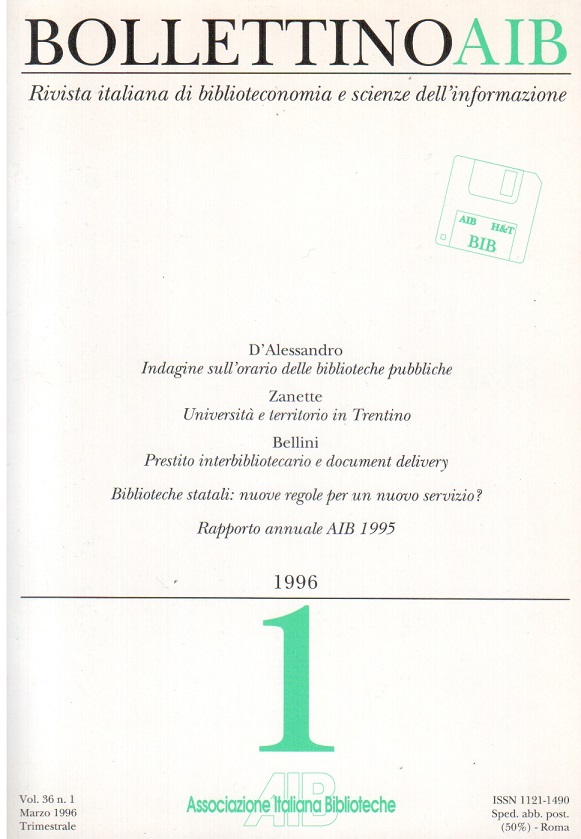Università e territorio in Trentino: un'esperienza di integrazione dei servizi bibliotecari
Contenuto principale dell'articolo
Abstract
Trentino is a special-statute province with ca 460,000 inhabitants. It is distinguished by an articulated network of public libraries, a well-established tradition of librarianship at the region's historic libraries, a young university, and a strong commitment on the part of the provincial authorities to enhance library services.
In 1962, under the aegis of Provincial Council, the University of Trento came into being as a free university with strong local links. In 1964, the university library was founded and the management entrusted to an council official. Despite the subsequent institution of new faculties and the division of the library's holdings among the various sites, management of the library together with the acquisitions, inventory and cataloguing activities remained centralised.
This unity has undoubtedly assisted the integration with the public library services as those who promoted the integration did not have to deal with a host of differing regulations and management practices.
In the 1970s, the Provincial Council sponsored the institution of modern public libraries in the region's biggest towns, and took responsibility for controlling said libraries' holdings, the quality of service and librarians' professional qualification. Before long, Trentino had 93 libraries which offered services to some three quarters of the region's population, a far cry from the ten or so town libraries the region had at the end of the 1960s.
At the same time, librarians set up cataloguing cooperation projects to show it was possible to develop knowledge and access tools for the historic holdings of important libraries. The principal lesson of such schemes was that it is necessary to know how many and which documents are held by the region's public and private libraries and that this information should be gathered and organised at a single site.
Article 9 of Provincial Law no. 17 of 1977 envisages the setting up of a union catalogue of the historic bibliographical holdings of Trentino's libraries. In 1981 another lax was approved which set up the Trentino Bibliographical Catalogue (Catalogo bibliografico trentino, CBT).
The main objective of CBT is to gather in a single database bibliographic information concerning the holdings of the various types of libraries in Trentino province. The integrated library automation program DOBIS/LIBIS was chosen for the catalogue.
At the start of the 1990s, the Provincial Council decided to set up a network which would interconnect all of Trentino's towns (TELPAT). This "backbone" can also be used to circulate bibliographical information and hence TELPAT allows the interconnection of all the public libraries which thus become access "counters" for a range of information which extends far beyond that actually held by a single library.
For the university, the possibility for students in towns to use their public library to gather information and borrow documents has alleviated the lack of study and reading space which is now a chronic problem in the university library. The sharing of information was the first concrete goal along the path to enhance library services. A provincial law of 1987 introduced the concept of the Trentino Library System (Sistema bibliotecario trentino, SBT) whose final objective is to offer a library service to all the province's inhabitants by promoting cooperation at all levels of management of all the Trentino region's libraries, whatever their nature and type. All the libraries which share information and documentary archives participate in the provincial interlibrary loan scheme.
However, for integration to be comprehensive further initiatives, in addition to those already undertaken, are required, such as the coordination of acquisitions, differentiated conservation policies, the sharing of information resources from outside the province, and the inclusion of school libraries in the SBT.
Dettagli dell'articolo

Questo lavoro è fornito con la licenza Creative Commons Attribuzione - Condividi allo stesso modo 4.0.
